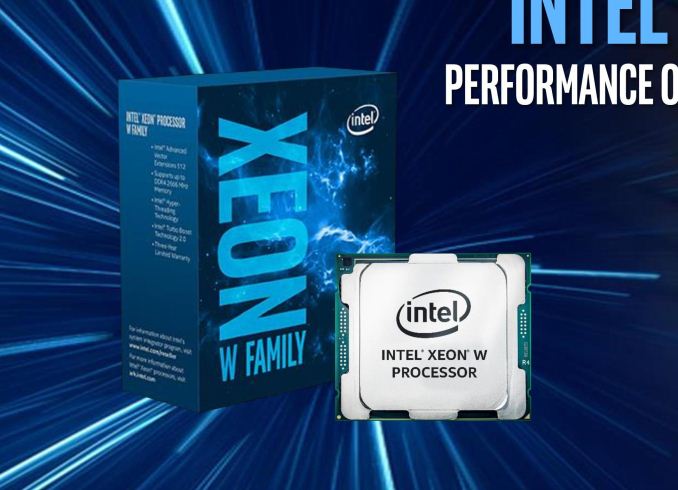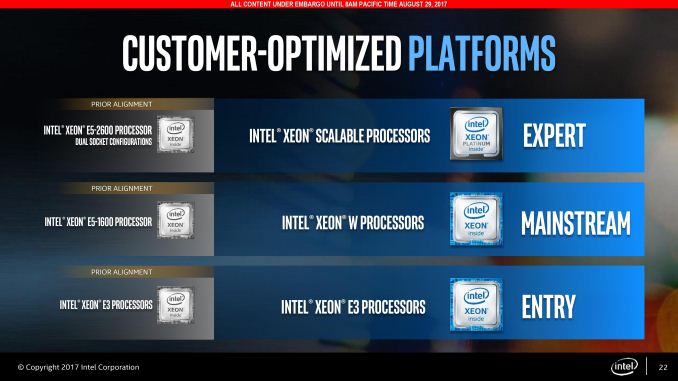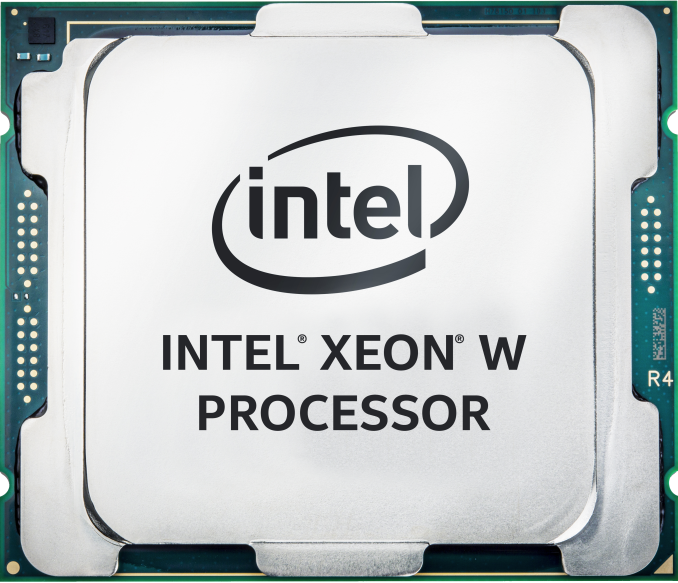Intel Launches Xeon-W CPUs for Workstations: Skylake-SP & ECC for LGA2066
by Ian Cutress on August 29, 2017 11:00 AM EST- Posted in
- CPUs
- Intel
- Enterprise
- Workstations
- ECC
- Skylake-SP
- LGA2066
- Xeon-W
- AVX-512
- C422

On the professional side of the CPU space, Intel’s new Xeon Scalable Processor family, based on the Skylake-SP architecture, is suiting up against the new EPYC processors from AMD. Part of Intel’s Xeon-SP launch was a rebranding of their product stack: gone are E5 and E7 families, and now Platinum, Gold, Silver and Bronze make for a confusing conversion. With this announcement, Intel also gave the image that now consumer and professional platforms were separate: no longer were Xeons welcome in consumer sockets. However as it turns out, this would not quite be the case.
Today Intel is taking the wraps off of their new Xeon-W family of processors, which will be their new brand for workstation-class processors. With the Xeon-W announcement today, Intel is bridging the gap between servers and consumer processors (in name at least) with a direct replacement for the old E5-1600 series, which will see Skylake-SP Xeons come to the LGA2066 socket with additional professional-level features in tow.
Historically, the E5-1600 series were identical processors to the E5-2600 series, except without the dual socket capabilities and consequently priced more appropriately for single socket workstations. Meanwhile over the last few generations, the consumer and enterprise platforms shared a socket, which made cross compatibility fairly easy.
With the new Xeon-SP processors, however, the enterprise platform went up to Socket LGA3647. This new socket is a far cry from the consumer LGA2066, losing a common platform in exchange for more memory channels and other features such as Omnipath. With a complete division between consumer and enterprise, there was no way to bring features such as ECC and vPro down into more consumer friendly environments.
Today’s launch of Xeon-W fixes this, although you probably still need a new chipset. As a replacement for the E5-1600 series, the Xeon-W CPUs will feature parts from 4 cores up to 18 cores, support up to 512GB of ECC RDIMM/LRDIMM memory, support dual 512-bit FMAs throughout the stack, and peak turbo clocks of 4.5 GHz.
| New Intel Xeon-W Processors (LGA2066) | |||||||
| Cores | Base Freq. |
Turbo 2.0 |
L3 (MB) |
L3/core (MB) |
TDP | Price | |
| Xeon W-2195 | 18/36 | 2.3 GHz | 4.3 GHz | 24.75 | 1.375 | 140 W | TBD |
| Xeon W-2175 | 14/28 | TBD | TBD | 19.25 | 1.375 | 140 W | TBD |
| Xeon W-2155 | 10/20 | 3.3 GHz | 4.5 GHz | 13.75 | 1.375 | 140 W | $1440 |
| Xeon W-2145 | 8/16 | 3.7 GHz | 4.5 GHz | 11.00 | 1.375 | 140 W | $1113 |
| Xeon W-2135 | 6/12 | 3.7 GHz | 4.5 GHz | 8.25 | 1.375 | 140 W | $835 |
| Xeon W-2133 | 6/12 | 3.6 GHz | 3.9 GHz | 8.25 | 1.375 | 140 W | $617 |
| Xeon W-2125 | 4/8 | 4.0 GHz | 4.5 GHz | 8.25 | 2.063 | 120 W | $444 |
| Xeon W-2123 | 4/8 | 3.6 GHz | 3.9 GHz | 8.25 | 2.063 | 120 W | $294 |
In essence, these are Xeon versions of the current Skylake-X (Core i9) processors with all the pro features enabled, such as the extended memory support, vPro, Intel’s AMT, and the standard enterprise Reliability, Serviceability and Availability (RAS) features. They will require a new chipset, the C422 chipset, and despite the common LGA2066 socket, the Xeon-W will not work with the consumer X299 chipset (reaffirming the split we see with the E3-1200 v5/v6 series which require the C236 chipset and will not work with the Z170 chipset). As a result, we are likely to see most of the major motherboard manufacturers pump out at least one version of an enterprise board to cover this market.
Starting at the bottom of the new Xeon-W product stack, we find something interesting: Intel is releasing a pair of four core parts that have 8.25MB of L3 cache, rather than the 5.5MB we would expect from a 1.375MB/core Skylake-SP design. This indicates that these parts retain access to some of the L3 cache attached to the disabled cores, making them particularly well suited for software that is licensed per CPU core and consequently needs the the highest single-threaded performnace possible. There are two 6 core members of the stack, which differ solely on clock speed. This is then followed by an 8 core, a 10-core, a 14-core and an 18-core, with no 12-core or 16-core present (although if launched, these are likely to be called the W-2185 and W-2165). All the parts will support 48 PCIe 3.0 lanes from the processor, suitable for 2x GPU and 3x PCIe storage direct from the CPU without going out to the chipset (in the consumer Skylake-X product line, the two bottom SKUs only have 28 PCIe lanes, and the rest have 44). Every processor in the Xeon-W stack sits at 140W, except the quad cores at 120W. By contrast, Skylake-X goes up to 165W. It is also worth noting that the Xeon-W processors only support Turbo Boost 2.0 rather than Turbo Boost Max 3.0 and its "favored core" underpinnings. And as with past Xeon processors, Xeon-W processors are also likely to be locked.
| Top SKU Comparison | |||
| Features | Skylake-X (i9-7980XE) |
Xeon-W (Xeon W-2195) |
Skylake-SP (Xeon 8180/M) |
| Platform | X299 | C422 | C620 |
| Socket | LGA2066 | LGA2066 | LGA3647 |
| Cores/Threads | 18 / 36 | 18 / 36 | 28 / 56 |
| Top Base/Turbo | 2.6 / 4.2 | 2.3 / 4.3 | 2.5 / 3.8 |
| GPU PCIe 3.0 | 44 | 48 | 48 |
| DRAM / DDR4 | 128GB UDIMM Quad-Channel |
512GB RDIMM+LRDIMM Quad Channel |
768GB/1536GB RDIMM+LRDIMM Six Channel |
| TDP | 165W | 140W | 205W |
| Price | $1999 | TBD | $10009 / $13011 |
There are several obvious comparisons that can be made between the Xeon-W family and both the consumer Skylake-X and the server Xeon-SP platforms. Intel’s goal here is to hit something in the middle: an increase in price over Skylake-X gets you more memory support, ECC, more PCIe lanes, and management features, but doesn’t go the full way to six-channels of DDR4 or multi-socket support. Not all of the Xeon-W parts have specifications and prices yet, but the 8-core processor is a good place to do comparisons.
| 8-Core Comparison | |||
| Features | Skylake-X Core i7-7820X |
Xeon-W Xeon W-1245 |
Skylake-SP Gold 6144 |
| Platform | X299 | C422 | C620 |
| Socket | LGA2066 | LGA2066 | LGA3647 |
| Cores/Threads | 8 / 16 | 8 / 16 | 8 / 16 |
| Base/Turbo | 3.6 / 4.3 | 3.7 / 4.5 | 3.5 / 4.2 |
| GPU PCIe 3.0 | 28 | 48 | 48 |
| DRAM / DDR4 | 128GB UDIMM Quad-Channel |
512GB RDIMM+LRDIMM Quad-Channel |
768GB RDIMM+LRDIMM Six Channel |
| TDP | 140W | 140W | 150W |
| Sockets | 1 | 1 | Up to 4 |
| Price | $599 | $1113 | $2925 |
The consumer Core i7 has fewer PCIe lanes and the most limited DRAM support, but it's the cheapest. Conversely, the Xeon Gold CPU is easily the most expensive, but it supports up to four sockets, has more L3 cache per core overall, and gets the greatest memory capacity, while incurring a slightly higher TDP in the process. The Xeon-W then sits neatly in the middle, taking advantage of high clock frequencies and pro features with a small bump in price, without forking over for multi-socket support.
Of course, we can put the Xeon W-2145 up against AMD’s Threadripper 1900X and EPYC 7401P too:
| Comparison | |||
| Features | Xeon-W Xeon W-1245 |
AMD Ryzen TR 1900X |
AMD EPYC 7401P |
| Platform | C422 | X399 | - |
| Socket | LGA2066 | TR4 | SP3r2 |
| Cores/Threads | 8 / 16 | 8 / 16 | 24 / 48 |
| Base/Turbo | 3.7 / 4.5 | 3.8 / 4.0 | 2.0 / 3.0 |
| GPU PCIe 3.0 | 48 | 60 | 124 |
| DRAM / DDR4 | 512GB LDIMM+RDIMM Four Channel |
128GB UDIMM Four Channel |
2 TB RDIMM + LRDIMM Eight Channel |
| L3 Cache | 11.00 MB | 32 MB | 64 MB |
| TDP | 140W | 180W | 155W/170W |
| Price | $1113 | $549 | $1075 |
For both parts that have the same core counts, Intel has the frequency advantage (and the performance advantage) and the power advantage, but AMD's chips have 60 PCIe lanes, more memory support, and are cheaper. When the 1950X doubles the cores but reduces the frequency, it still comes out cheaper than the Xeon W. Intel still has dual 512-bit FMAs/AVX-512 support, which Intel says is a big bonus in this market, and will point to its single thread performance.
While today is the formal announcement of the Xeon-W family, Intel has not announced much in the way of release details other than that the 14/18 core parts will be available in Q4. The rest are likely to come to market sooner, and we have requested details on retail availability. We’ve also had a lot of requests for workstation level testing or Xeon vs EPYC, and we’re in touch with both companies to get our hands on processors as soon as we can.
To clarify, we're still waiting on information about CPU/chipset support, and if Xeon-W will be supported in X299 motherboards. We will update this piece when we get that information.
Update 1
We fired a few questions to Intel, and got a few answers.
- Chipset Support: Xeon-W will only work in C422 motherboards. C422 motherboards will not accept Core-X processors.
- DRAM: 128GB LRDIMMs are not supported. Intel feels this level of value does not benefit workstation users and directs them to the M versions of the Xeon-SP lines.
- Turbo Boost 3.0: Intel is not supporting this on Xeon-W, but has engineered TB2 to match the same frequency.
- Mesh Frequency: Intel refuses to disclose this publicly, even though anyone with a CPU could poll it to get the result. This was an odd response to this request.
Also on retail availability: Up to 10-core parts are available from OEMs from August 29th (today). However, only W-2123 and W-2135 are going to be on the shelf in official retail packaging. End users will have to procure the other parts through non-retail packs.




















50 Comments
View All Comments
Elstar - Tuesday, August 29, 2017 - link
It is way more complicated than the headline numbers imply. To AMD's credit, they've achieved a great bang-for-buck ratio for certain workloads. That being said, they did take some architectural shortcuts to get those headline numbers. If you need a CPU that has a well balanced design, Intel is still the better choice / safer default.ddriver - Tuesday, August 29, 2017 - link
Are you kidding me? At the value AMD is offering, you can spend the same amount of money on CPU power that will outperform intel even at those few "architectural shortcuts" targeting, extremely narrow niche workloads, and pretty much destroy intel at everything else.Safer... yeah, there is nothing safer than paying a 50% price premium just for the brand. But only if by "safer" you mean "dumber".
Elstar - Tuesday, August 29, 2017 - link
This is a good article on the tradeoffs between AMD and Intel's latest offerings:http://www.anandtech.com/show/11544/intel-skylake-...
ddriver - Tuesday, August 29, 2017 - link
You do realize that you link to something that shows AMD beating intel bit time in everything save for the single most shamelessly biased test in human history, right?AT's notorious "glued cores are bad for databases mkay" test, which runs a few MB worth of database on a 64 core, 128 threads, and the WHOOPING 512 GIGABYTES of ram machine.
Who does that? I mean in real life? I mean other than the expert AT crew, which carefully picked the database size small enough to fit entirely in the cache of xeons, but large enough to not fit in the cache of a zen CCX? AT sinking to a whole new level of low just to save intel the embarrassment of being whooped in every single test, be that at a completely pointless, senseless and obviously fabricated for bias test, as AT staff well knows the intellectual capacity of the bulk of its readers, and that it is low enough for that crap to pass.
The only architectural advantage intel has is AVX512, which first and foremost, is very very far from adoption, and second - makes little to no sense for servers.
To which I say "GOOD JOB AMD", for once they didn't shoot themselves in the foot by putting extra transistors into features that won't see decent adoption in the life cycle of the product and generally don't make sense in the target market.
Ryan Smith - Tuesday, August 29, 2017 - link
"Who does that? I mean in real life? I mean other than the expert AT crew, which carefully picked the database size small enough to fit entirely in the cache of xeons,"The database, though not large, was large enough not to fit into the cache of any of the processors we tested. It was around 120MB in size.
ddriver - Wednesday, August 30, 2017 - link
Well, it still unrealistically benefits intel chips. A database of the size AND access patterns of real-world application would have mitigated the latency penalty of inter-CCX access down to negligible. Until you go back and revise that test with a proper real world scenario, it remains obviously biassed to save face for intel. And don't give me the "we were in a hurry" nonsense, writing a script to populate a database takes a minute as does its population with several gigabytes of data on a modern machine. Or you could even invest like 10 minutes in a very useful and reusable script to also emulate the typical access patterns.MrSpadge - Wednesday, August 30, 2017 - link
So the test with a 120 MB database unfairly favors the CPU with 11.5 MB L3 compard to the CPU with 64 MB L3? Yeah, sure...(that's what the guy was comparing that you answered to)
Honestly, I don't think there's anything AT could do to make you stop complaining.
Icehawk - Thursday, August 31, 2017 - link
This guy is a troll - no clue why he insists on posting or reading here since AT is such a biased and crappy site.FYI, it doesn't matter how good AMD's iron is, our shop will only buy Intel just like 99% of other businesses. I am glad to see they have decent offerings but they will need several successful cycles before they become a real consideration to most IT departments. In 20yrs as a sys admin in companies from 20-50,000 I've literally never seen a single AMD server or workstation and just a handful of (very) low end laptops. Intel is a known quantity and businesses are loath to go into the unknown. You may not like this but it is true.
I still have my Athlon with Golden fingers in a box with a VooDoo2 and other relics, that proc was a game changer and on the desktop it looks like Ryzen may stand a chance of ending up on users desktops but again, not in the enterprise.
smilingcrow - Tuesday, August 29, 2017 - link
Balance is the key as when you look at the TCO for a server with hardware and software these price differences for some purchasers aren't relevant.For others the AMD chips are very appealing though and not just on price.
ddriver - Tuesday, August 29, 2017 - link
There is loads of high quality, enterprise grade server software that is completely, 100% free. You only pay for professional support, and only if you need it, and the price is not dependent on the amount of cores you run.So software price is really kind of a moot and desperate point. Desperate to come up with advantages of buying intel hardware.